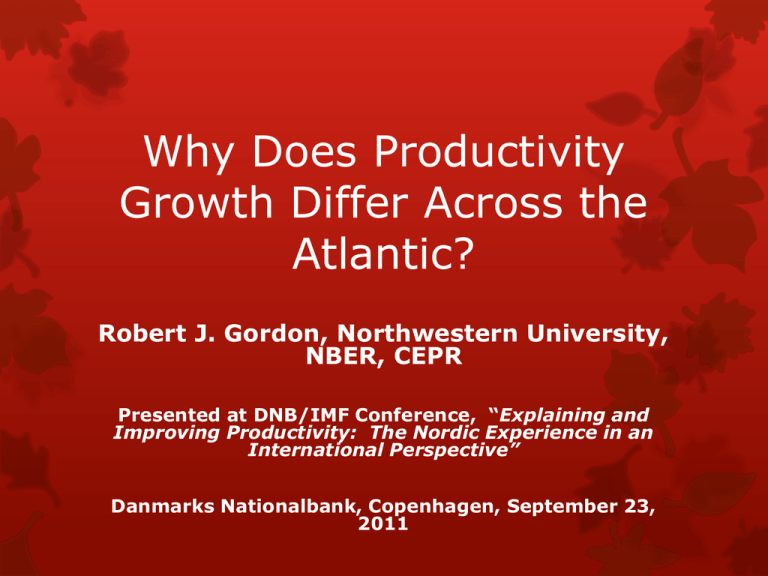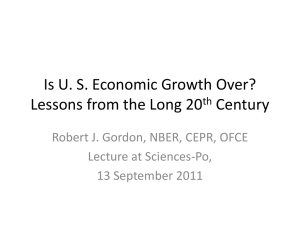Okun`s Law, Productivity Innovations, and Conundrums in Business
advertisement

Why Does Productivity Growth Differ Across the Atlantic? Robert J. Gordon, Northwestern University, NBER, CEPR Presented at DNB/IMF Conference, “Explaining and Improving Productivity: The Nordic Experience in an International Perspective” Danmarks Nationalbank, Copenhagen, September 23, 2011 This Is an Enormous Topic Productivity growth has differed across the Atlantic since the beginning of modern macro data around 1800 At Least Four Dimensions History US vs EU vs DK 1820-1970 History US vs EU vs DK 1970-2010 The total flip in relationships of employment and productivity after 1995. Why did US take off? Change in cyclical relationships 2007-11 Why did all this happen?? It’s Time to Switch Colors So far, the red and white prove to you that I know the colors of the Danish flag I am not an expert on the Danish economy, so much of my talk will be about comparisons between the US and the EU-15 over these historical eras Most of the Talk Will Be About the US vs. EU-15 • How do we interpret the fact that the US caught up to and surpassed the EU standard of living around 1900? • What happened in the US and EU that allowed the US to take its great leap forward 1910-50? • Was the EU “Golden Age” (les trentes glorieuses) anything more than catch-up to the US frontier? • Why did the US grow slowly 1970-1995 thus allowing EU productivity almost to catch up? • Why did the US surge ahead after 1995? • Is the US productivity revival over? What is the long term outlook for the US as the traditional location of the productivity “frontier”? Abbreviations to Distinguish the Main Concepts • • • • Y = Real GDP H = Aggregate hours of work N = Population Thus we have the central ratios used in the analysis of standards of living and productivity Y/H = output per hour = labor productivity Y/N = output per capita = standard of living They differ as H/N changes, hours per capita The Very Long Run, EU/US and DK/US Ratios of Real GDP Per Capita • What you’ll see is an interesting history, mainly reflecting the instability of the US • DK, EU ratios decline 1870-1913 reflecting America’s advance to the frontier of productivity • From 1913 to 1950 instability reflects the World Wars and US Great Depression • Let us focus on ratios for 1870, 1920s, and postwar US vs. Europe, 1870-1913 • Unbelievable U. S. population growth. 1870=40 million, 1910=90 million • A large unoccupied continent flooded with eager immigrants, many given free land by the Federal government – As usual, immigrants were self-selected. Smarter, more able than average • 1870-1910 expansion of the RR network from 60,000 miles to 250,000 miles • The internal Common Market promoted economies of scale in production and in marketing • Sears catalog as the symbol of US market integration in 1900-1929. Sears Catalog of 1905 • Combines economies of scale in purchasing – Sears catalog listed thousands of items – They were purchased in volume from manufacturers – Facilitated economies of scale in production, allowed manufacturing firms to grow large enough to supply the national market • Economies of scale in marketing – Each item sold at the same price from Maine to California, Idaho to Florida – The “Wells Fargo Wagon” song set in a small Iowa town about 1905 • Much of the 2nd Industrial Revolution occurred in US: electricity, internal combustion engine, telephone, phonograph, motion pictures, airplane (Germany ICE, chemicals, pharmaceuticals) – Most important invention? Running water and indoor plumbing Further U. S. Advantages • Even if there had been a USE, America would still have pulled ahead • Abundance of natural resources promoted resource-related innovation – Agricultural machinery – Scarcity of labor promoted development of machinetool industry • Auto dominance? The causes included vast distances and the general prosperity, not only in the cities but among farmers who could buy cars and trucks The Contrast in Europe • Tariff barriers, German economic expansion of late 19th century built on walls of protection, even between GE and NL • Innovation directed toward self-sufficiency in case of war • Drain of military arms race, could Germany build dreadnoughts (battleships) as fast as UK 1900-1913? • In contrast enlightened government in US was devoted as single-mindedly to economic growth as China is today: – Homestead act, subsidies to RR, establishment of agricultural experimentation stations and land-grant state universities • US education – population literate by 1870, led world in expansion of secondary education 1910-1940 • Qualification: German and Swiss firms dominated the development of the chemical and pharmaceutical industries 1870-1920 The US Great Leap Forward, 1910-41 • Electrification. – Most homes had electricity by 1929 – Manufacturing productivity jumped especially in 1914-23 due to electrification • Internal Combustion Engine – In 1929 the US produced 80% of the world’s motor vehicles, accounted for 90% of the world’s auto registrations – The ability to build 6 million motors in 1929 was the key to the WWII “Arsenal of Democracy” – Yes, the Soviet Army defeated Hitler, but with the aid of 400,000 Dodge trucks provided for free by lend-lease • Secondary education became universal in the US between 1910 and 1940 • David Landes: Paris in 1948 = US in 1912 • The post-war EU and DK catch-up The Golden Age of 1945-73 • The US was not standing still • The 1930s despite the Depression experienced rapid technological change • Alex Field’s new book “Great Leap Forward” – Examples: Commercial aircraft, fast powerful automobiles, motion pictures (4/10 AFI 1939-42) • World War II, government subsidized invention of the computer, radar, nuclear power US History: Growth in Output per Capita and Output per Hour Beyond the Postwar Catchup: The Last 50 Years • The main themes of the next graphs • EU and DK continued to catch up in Y/H not just until 1973 but until 1995 • Sources of catchup: slow growth in US 197395 – Entry of women and teenagers into the labor force – Diminishing returns to the great inventions – Delayed productivity benefits of the computer Pause to Consider the Big Questions of Transatlantic Differences • The previous charts show that EU productivity caught up until 1995, then fell back • This implies EU growth rate of Y/H was faster than US before 1995, slower after 1995 • Why the sharp change in behavior after 1995? Not just in productivity but also in growth of H/N – Before 1995 EU hours per capita (H/N) grew slower than US, productivity (Y/H) faster, income per capita (Y/N) the same – After 1995 H/N grew faster than US, Y/H grew slower than US, Y/N continued to grow at the same rate • The evolution of the trends US vs EU: Trend Four-Quarter Growth of Output, Hours US vs EU: Trend Growth of Labor Productivity The Contrast Before 1995 • EU hours per capita declined for three reasons – Higher unemployment after 1980 than before 1980 – Lower labor-force participation, big contrast in female LFPR between Nordic and Mediterranean countries – Shorter hours, longer vacations • EU Y/H growth artificially high because of slow hours growth, movement NW along labor demand curve • US: everything opposite. Women, teenagers increased H/N, held down Y/H – US: fast growth of employment in low-skill service sector jobs that hardly existed in Europe – Grocery store baggers, restaurant bus boys, parking lot attendants, valet parkers Everything Changed After 1995 • US frontier moved out with the invention of the internet, the marriage of PCs with communication – Dot.com stock market bubble 1995-2000 – Permanent impact on productivity, Y/H growth revived 1995-2000, continued 2001-04, then slowed down • Two questions about Europe – Why did H/N start growing faster? – Why did dot.com innovation not travel across the Atlantic? Faster Growth in EU H/N After 1995 • Similar trade-off between growth in H/N and Y/H, with Y/N neutral • Just as female LFPR surged in US 1965-90, so did female LFPR rise rapidly in southern EU esp. Spain and Italy after 1985 and esp. after 1995 • Artificial hours-reducing, Y/H enhancing policies were loosened or reversed after 1995 – EPL, PMR, unions – Lower-tier employment status emerged in several countries Why Did IT dot.com Revolution Not Travel Across the Atlantic? • • • • The computers are everywhere Retailing as reliant on bar-code scanning as in the US What’s different? Timmer, van Ark, and the Groningen Team – Smaller share of market services in EU – Economies of scale in US retailing – Big boxes in US retailing compared to small shops in protected European inner-city walking zones – Policy recommendations: reform land-use planning (but that’s not going to change Paris or Rome!) • My walking tour observations (Rome in 4/11, Paris on 9/14/11) Differences Within Europe • Computer and internet intensity in Nordic countries is as high as in the US • The EU average is held down by the “olive belt”: PO, SP, IT, and GR • The EU disadvantage goes beyond retail. It also includes wholesale and business services – One can see the wholesale productivity shortfall any day on the streets of Rome or Milan The Dominant US Role in the IT Revolution since 1995: Why? • American firms have dominated, both hardware and software – Intel, Microsoft, Apple, Dell, Google, Facebook • Why does innovation occur on the west coast of America? • American leadership is greater in software than hardware – The advantage of the English language • Underdevelopment in continental Europe of venture capital and equity finance • Overdevelopment in Europe of corporatist institutions that protect existing enterprises and worker groups while suppressing innovation • Pharmaceuticals, a special case. Lack of price controls in US leads to high drug prices, the US consumer and insurance companies subsidize drug research that benefits the rest of the world. What Are Some of the European Barriers to Innovation? • Licenses and Permissions set a barrier to starting new firms – Italy is the extreme. A country run by protection of established groups, laws written by lawyers to protect lawyers • Union rules that require consultation with workers about what products will be produced and where they will be produced (Recent US example of Boeing in Charleston SC) • European reliance on bank finance and lesser role of equity finance Cultural Differences Matter in Explaining Differences in Innovation • Traditional Aspect of European Culture: Disdain for money-centric Americans with their big rewards for success • American children are exposed to the market earlier than European children – Baby-sitting – Jobs as burger-flippers at McDonalds in their teens – Forced to work during college in contrast to European college students who expect a government-financed “free ride” • European tradition of long-term youth unemployment, adult children living at home with their families – Great Recession has created a similar phenomenon in US Higher Education in US as a Font of Innovation • Why is Silicon Valley located in Santa Clara County of California? – Because of its proximity to Stanford University • US leadership in higher education comes from its dual public + private higher education system – Private universities, funded with alumni contributions, provide lavish facilities for faculty research – But they also create rampant cost inflation in higher education as significant as in U. S. medical care • Federal government support of higher education does not take the form of tuition grants as in Europe • Instead, government promotes research through competitive, peerreviewed grants administered by NIH and NSF • Promotes a meritocracy of young research faculty forced to devote their early career to innovative research. – Especially compared to Germany, less hierarchy, less authority of senior professors GDP Data Understate Europe’s Standard of Living • US Harsh Climate – Excess energy use is counted in GDP but does not raise welfare compared to Europe – Natural disasters and insurance costs • Expenditures on prisons • Excess reliance on motor vehicles, starvation of public transit, excess dispersion of metro areas with resulting highway congestion Transition to the Bleak Outlook for the US Economy • Everything I’ll talk about was true in 2007 • No adjustment for the ongoing effects of the “Great Recession” • No adjustment for loss of skills, loss of human capital, decline in capital stock as factories have closed • Listen with a Danish perspective – how much of my US pessimism applies to DK, how much is the US unique? Where is the US Productivity Frontier Headed? A Pessimistic Outlook • The history of the frontier • Industrial Revolution #1 (IR #1): England 1760-1830. Steam, railroad, steamships, cotton • Industrial Revolution #2 (IR #2): Largely US 1870-1910. Electricity, Internal Combustion Engine, Water and Indoor Plumbing, Chemicals, Entertainment • IR #3. Computers: Mainframe, PC, PC+Communications=Internet, Broadband, Miniaturization • My radical hypothesis. No economic growth 10000BC until 1750AD. Three great centuries 1750-2050. But after that, economic growth will be over in US and possibly elsewhere Does IR #3 Measure Up to IR #2? • The pace of economic growth has been propelled by the three IR’s • IR #2 is a much bigger deal than IR #3 • The expansion of the standard of living frontier is less under IR #3 • Most of the big benefits of IR #3 for business productivity happened early, before 2001, with bar-code scanning and electronic catalogs • The implication is that the scope for future productivity growth matching the rate from 1870 to 1970 is quite limited What About the Future of IR #3? The Folly of Forecasting • In 1876 an internal memo at Western Union, the telegraph monopolist, said that “the telephone has too many shortcomings to be considered as a serious means of communication.” • In 1927, a year before the first talking motion picture, the head of Warner Brothers said “Who the hell wants to hear actors talk?” • In 1943 Thomas Watson, president of IBM, said “I think there is a world market for maybe five computers.” • In 1981 Bill Gates, defending the capacity of the firstgeneration floppy disk, claimed that “640 kilobytes out to be enough for anyone.” But We Don’t Need to Forecast • Even if IR #3 continues to deliver inventions, the tailwind of technology is confronting five headwinds. • We’re talking now about the U. S. only, but I’d be interested in your reaction – how many of these headwinds does Denmark face? • The five categories: inequality, globalization, environment, education, debt The Stunning Implication of Rising U. S. Income Inequality • Let’s say U. S. income per capita is growing at 1.5 percent per year while Denmark is growing at 1.3 percent per year. • The U. S. is doing better, right? Wrong? • Income inequality has been rising in U.S. but not in Denmark • The U.S. growth of 1.5 percent for the entire population translates into only 0.9 percent for the bottom 99 percent. • Don’t believe it, look at the data of Piketty-Saez, two world-famous French economists Table 1. Real Annual Income Growth by Groups, 1993-2008 Average Income Top 1% Incomes Bottom 99% Incomes Real Annual Growth Real Annual Growth Real Annual Growth Fraction of total growth (or loss) captured by top 1% (1) (2) (3) (4) 1.30% 3.94% 0.75% 52% 4.0% 10.3% 2.7% 45% -6.0% -16.8% -3.3% 57% Bush Expansion 20022007 3.0% 10.1% 1.3% 65% Great Recession 20072008 -9.9% -19.7% -6.9% 47% Full period 2008 1993- Clinton Expansion 1993-2000 2001 Recession 2002 2000- The U. S. Top Decile Income Share, 1917-2008 Top 0.1% Income Shares in the U.S., France, and the U.K.,1913-2007 Second Headwind: Globalization merges with Internet to Destroy Jobs • Explaining the Autor-Katz “polarization hypothesis.” – Upper level, creative, contact essential – Mid-level white collar. Not creative, easily outsourced – Bottom-level, contact essential. Waiters, bartenders, truck drivers, nurses • Inventing the internet has worked against the US. • Instant computer access from anywhere is carving out the mid-level white collar jobs – Replaced by machines – Replaced by outsourcing • Implication for “the end of economic growth”, continued shortfall of median income growth below mean income growth Third Headwind: Environment • Like a massive debt hangover, global warming requires sacrifice of living standards – Carbon taxes – Constraints on which uses of energy are allowed – Household disposable income is diverted into spending on insulation and new energy-efficient cars and appliances which don’t provide services any better than what they replace. • Payback for 140 years of growth created by IR #2 • Advanced countries forced to sacrifice because of catch-up in the emerging fast-growing nations • Controversial analysis about policy implications, uncontroversial that this will slow growth Fourth Headwind: The Dismal U.S. Education Situation • U.S. higher education is much admired, but the main achievement is in the past – U.S. has fallen from 1st to 8th in college completion – Cost inflation in higher education is as significant as in medical care – Costs at state universities rising faster because of state budget shortfalls – Many American students are being priced out of higher education – Who is attending in their place? The 500 Chinese applicants at tiny Grinnell college in Iowa • My story about Asian names in my Econ 311 class – Increasingly, Asian immigrant students are heading home after graduation Even More Dismal is American Primary and Secondary Education • The OECD PISA tests in reading, math, and science • Ranks of US within OECD (37 countries) – Reading #17 – Science #23 – Math #31 • 75 percent of Army enlistees rejected because of poor test scores or previous criminal records • Only 35 percent of American high school students are prepared for college • Much of America’s college participation is in 2-year community colleges which are glorified high schools, with most courses remedial, low graduation rates, and few transfers to 4-year colleges • Outcome: ever more American firms are complaining about inability to find skilled workers, despite 16 million unemployed. – The unemployed are unskilled or those whose skills are now irrelevant – The H1-B visa problem, the immigrants who accounted for 35% of Silicon Valley start-ups Fifth Headwind: Consumer and Government Debt • Household debt as % of disposable income went from 90% in 1995 to 133% in 2007, since then is back down only to 119%. Year after year of deleveraging will follow • Federal government deficit the result of – Irresponsible Republicans, cut taxes 2001-03 while starting two wars with no revenues to pay for them – Then the deep revenue hole from the great recession – Federal tax revenue has fallen from a postwar average of 19% of GDP to 15% • Democrats also deserve blame: their role in state government deficits. Unions and democratic local politicians in bed, promoting Greece-like early retirement ages, lavish pensions and medical care benefits, without any revenues to pay for it • CA, IL, NJ, NY are the American equivalents of Greece Implications of the Five Headwinds on Future Economic Growth • Inequality will hold median income growth below average income growth • Globalization will continue to hollow out the previous routine white and blue collar jobs in the former middle class • Environment will either be ignored or will slow growth in consumption of non-energy-related products • Poor education will lead to more outsourcing, more unemployed high-school dropouts, and increased movement of American firms to foreign locations • Consumer debt means that consumption will grow slower than income; government debt means that more people will lose their jobs from expenditure cuts, and incomes after taxes and transfers will decrease relative to incomes before taxes and transfers. Conclusion: Let’s Buttress This History With Some Numbers • You’re about to see bar charts tracing U. S. economic growth since either 1870 or 1891. • We’ll distinguish different concepts of economic growth – – – – Real income per capita Real consumption per capita Average labor productivity Total factor productivity • Both unadjusted and adjusted for changes in capital and labor quality • For each concept we’ll compare history with a coherent forecast for 2007-27 – This does NOT take into account any long-run damage from loss of human or physical capital in the Great Recession Growth in Output and Consumption per capita since 1870 The Consumption-GDP Ratio Since 1869: Why It’s Payback Time The Distinction Between Output per Capita and Output per Hour Explaining the Difference: Growth in Hours per Capita Unadjusted MFP Growth By Itself The Bottom Line: The Different Chronology of Consumption and MFP The Message of the Charts • The underlying assumption is most optimistic: unadjusted MFP growth in 2007-27 will be faster than 1988-2007 and indeed faster than at any time since 1964 • Yet growth in consumption per capita will be slower than at any time since 1870, except for 1913-28 (surely a phony number) • Why the difference? – End of growth in educational attainment – Reduced hours per capita due to retiring baby boomers – Reduced C/Y ratio due to indebtedness overhang But An Ever Bigger Message • Projected growth of consumption per capita of 1.0% ignores growing inequality. For the bottom 99 percent of the income distribution, it could be 0.5% or less. • Consumption could also be held down by government debt reduction due to pension reform, slower growth in transfers, higher taxes • We’ll be perilously close to zero growth in consumption per capita over the next 20 years, even starting from a 2007 base that ignores the destruction in human and physical capital that has occurred since 2007 as a result of the Great Recession Interpreting the Past Decade: Trend vs. Cycle • Productivity, Hours, employment bound together by an identity • Y/N = Y/H * H/N • Introduce employment • Y/N = Y/H * H/E * E/N • By definition, a recession causes a sharp drop in Y/N. By definition, this event must be divided up in responses of Y/H, H/E, and E/N • To interpret recent decline in EU Y/H, we must adopt a systematic framework for discussing cyclical adjustment of Y/H, H/E, and E/N Traditional Okun’s Law Response, First Let’s Look at US, then later EU • Okun wrote in 1962 • We can translate his “Law” into the language of “gaps” • A “gap” is the log ratio of actual to trend • Notation: Y is actual real GDP, Y* is trend real GDP, Y’ is the output gap • The output gap is defined as: • Y’ = 100*LN(Y/Y*) Okun’s Law, dividing up the gaps • Okun: let output fall in a recession, bringing the output gap from 0 to -1. • How will the other components behave? • Y/N drops by 1 • Y/H drops by 1/3 • H/N drops by the remaining 2/3 • Of this 2/3 response, 1/2 is employment • Remaining 1/6 is hours per employee (H/E) My Current Research: The Demise of Okun’s Law in US • Run regressions to estimate elasticity of labor gaps to output gap, allowing for lags and other nuances • For US: split sample period 1954-86 and 1986-2011 • Okun in 1962 predicted response would be 1/3 Y/H, vs. 2/3 H/N • Actual data for 1954-86, 0.25 Y/H, 0.75 H/N US: Long-Run Responses, Before and After 1986 Implications of Regression Analysis • Okun’s Law is overturned, Hours now respond by >1 to output deviations, not <1 • Productivity no longer responds procyclically to output fluctuations – – – – No more Okun’s Law No more SRIRL No more RBC No more procyclical “technology shocks,” i.e., productivity fluctuations as exogenous inputs in DSGE and other modern macro theories Now We Turn to Comparison of US and EU • The motivating puzzle, shown on the next slide, is that conditional on the decline in output, U rate increased more in U. S. than in EU • To avoid keeping track of 15 countries, we study only the EU-15 aggregate • Some of data are for Euro Area, not EU-15 • Reason horizontal axis is change in output, not output gap (OECD gaps are implausible) Relationship of Unemployment and Output in US and EU The graph shows the relationship between the cumulative growth rates of output and unemployment in the recession. The US is an outlier: the increase in unemployment is higher than the decrease in output would predict The slope of the line is about -1/2, and Denmark is right on the line US vs EU: Cumulative Change of Output and Unemployment 07-10 Observations on Gaps in US and EU • Output gaps restate the result that the depth of the recession of 08-09 was about equal in US and EU • Hours gap is much more negative for the US, with a trough of -8.7 percent versus -4.4 percent for EU • Leads to a higher productivity gap for the US during the recession, even briefly going positive • US had an earlier and shorter lived drop in productivity gap during the recession, even relative to higher trend productivity growth US vs EU: Gaps for Output, Labor US vs EU: Gaps for Productivity (Output per Hour) US Long Run Responses EU Long Run Responses This Analysis is Essential to Understand Current EU Productivity • Need to distinguish actual data from underlying trend • In US-EU comparisons, need to separate US faster productivity trend from its “Demise of Okun’s Law” high cyclical response of hours, low cyclical response of productivity • In EU data Okun’s Law is “Alive and Well”. Much of recent decline in productivity growth is cyclical Unified Explanatory Hypothesis: “American Exceptionalism” • Joint explanation of changes in American and European behavior • American shifts toward greater labor response explained by “disposable worker” hypothesis • Europe’s opposite shift explained by the absence of the conditions of the “disposable worker” idea and by differing institutions and policies that promote work sharing. Substantive Explanation of U.S. Increased Flexibility of Labor Input • Disposable worker hypothesis • Based on increased managerial power, diminished worker power • Separate causes at top and bottom • Same set of causes that has been developed previously to explain rising U.S. inequality The U. S. Disposable Worker • Explains both rise in cyclical responsiveness and of income inequality • Ingredients in increased management power: exec pay based on stock options, sensitivity to 2000-02 and 200709 stock market debacles • Stock options help explain huge increase in share of top 1 percent 1982-2000 and fluctuating share since then. Stock option income treated as labor income • Increased emphasis by management on maximizing shareholder value Not just Strong Management, Weak Workers • Contributions of weak labor bargaining power the same list as the sources of increased income inequality in the bottom 90 percent – Reduced share of work force was unionized – Unions became weaker – Lower real minimum wage – Globalization: low-skilled immigrants and low-cost imports Explanations for EU Behavior • Three broad differences between the US and Europe offer a point of departure for developing explanations: – 1) Different evolution of inequality – 2) Longstanding European regulations that protect employment – 3) Explicit European institutions encouraging work-sharing and reducing hours, both in the long run and during a downturn Differences in Inequality • The U.S. exhibited a move toward maximizing shareholder value and cost-cutting. This move has the same causes as the increasing income inequality in the U.S. as compared to Europe. • Factors leading to lower European inequality and lower responsiveness of labor to output: – Smaller role of short-term profit maximization in management – Greater power of unions – Corporatist tradition: unions join with management in making decisions that ultimately effect labor responsiveness Differences in Inequality (cont.) • Income share of top 0.1 percent in the US quadrupled from 2 to 8 percent between 1975 and 2000. • Top share in France has remained remarkably stable, increase in U.K. has been relatively moderate compared to U.S. • Gini Coefficients in 2007: EU Average = 0.31, US = 0.45 • Cultural customs and institutions (e.g. traditional role of labor of German corporate boards) play a large role in determining inequality. • US unions have very little influence over management, leading to decisions that can cut jobs and make labor much more responsive to output swings Conclusions for Macro • US Changes after 1986 – Okun’s Law is Dead – Procyclical productivity innovations are dead – RBC model and “technology shocks” are no longer relevant as core determinants of business cycles • Europe – Analysis shows that changes in the responsiveness of labor and productivity have occurred in U. S. but not in Europe • Overall Conclusion: Institutions Matter!







